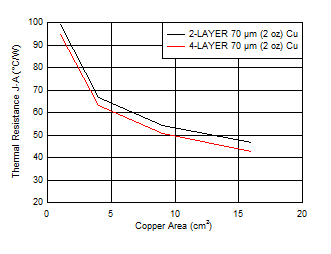SNVS853E August 2012 – August 2018 LMZ21701
PRODUCTION DATA.
- 1 Features
- 2 Applications
- 3 Description
- 4 Revision History
- 5 Pin Configuration and Functions
- 6 Specifications
- 7 Detailed Description
- 8 Application and Implementation
- 9 Power Supply Recommendations
- 10Layout
- 11Device and Documentation Support
- 12Mechanical, Packaging, and Orderable Information
Package Options
Refer to the PDF data sheet for device specific package drawings
Mechanical Data (Package|Pins)
- SIL|8
Thermal pad, mechanical data (Package|Pins)
Orderable Information
10.1.3 Provide Thermal Path and Shielding
Using the available layers in the PCB can help provide additional shielding and improved thermal performance. Large unbroken GND copper areas provide good thermal and return current paths. Flood unused PCB area with GND copper. Use thermal vias to connect the GND copper between layers.
The required board area for proper thermal dissipation can be estimated using the power dissipation curves for the desired output voltage and the package thermal resistance vs. board area curve. Refer to the power dissipation graphs in the Typical Characteristics section. Using the power dissipation (PDISS) for the designed input and output voltage and the max operating ambient temperature TA for the application, estimate the required thermal resistance RθJA with the following expression.
Then use Figure 80 to estimate the board copper area required to achieve the calculated thermal resistance.
 Figure 80. Package Thermal Resistance vs. Board Copper Area
Figure 80. Package Thermal Resistance vs. Board Copper Area For example, for a design with 12-V input, 5-V output, and 1-A load the power dissipation according to Figure 7 is 0.53 W.
For 85°C ambient temperature, the RθJA-REQUIRED is ≤ (125°C – 85°C) / 0.53 W, or ≤ 75°C/W. Looking at Figure 80 the minimum copper area required to achieve this thermal resistance with a 4-layer board and 70 µm (2 oz) copper is approximately 3 cm².